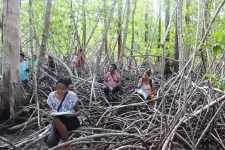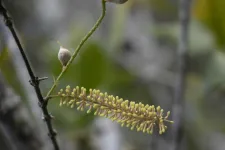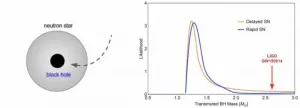(Press-News.org) In a new paper published in Light: Science & Applications, the group led by Professor Andrea Fratalocchi from Primalight Laboratory of the Computer, Electrical and Mathematical Sciences and Engineering (CEMSE) Division, King Abdullah University of Science and Technology (KAUST), Saudi Arabia, introduced a new patented, scalable flat-optics technology manufactured with inexpensive semiconductors.
The KAUST-designed technology leverages on a previously unrecognized aspect of optical nanoresonators, which are demonstrated to possess a physical layer that is completely equivalent to a feed-forward deep neural network.
"What we have achieved," explains Fratalocchi, "is a technological process to cover flat surfaces, which in optical jargon are called "flat optics," with "physical" neural units that are able to process light as a neural network does with an electrical signal."
These innovative flat optics achieve near unity efficiencies (up to 99%) in the visible range in ultrathin surfaces, which provides broadband and vectorial light control in both transmission and reflection with the desired wavefront shape. Moreover, the nanoshape silicon surface is ultrathin (60 nanometers thick, 1 nm=1/1000000 of 1mm) and can be customized on flexible surfaces.
The program used to design the nanosurface runs on KAUST's Shaheen-II supercomputer, a Cray XC40 delivering over 7.2 Pflop/s of theoretical peak performance, and is carried out with the Autonomous Learning Framework for Rule-based Evolutionary Design software developed by Fratalocchi and his team.
"We have developed a program that uses artificial intelligence to design the nanoresonators. The algorithm works using evolutionary techniques: in simple terms, the algorithm is able to train itself and improves its results after every cycle to produce surfaces of increasing efficiency every time that it is run. In our article, we showed experimental components with better performance than the current state of the art in flat-optics or from commercial devices available from leading companies, such as Thorlabs and Newport."
The KAUST research team is currently planning to use flat optics to develop new flat devices that could revolutionize older technologies based on bulk optics. Among the innovations, Fratalocchi and his team are building a human-eye camera, a bio-sensor able to "read" cells infected with malaria and new types of displays.
"There are really endless applications," explains Fratalocchi, "because almost all existing measurement systems, in principle, could be substituted by their cost-effective, compact flat-optics versions. We are developing a statistical learning approach that, for any given measurement task, designs a corresponding flat-surface that "encodes" the measure into a single optical image, or logogram. With this approach, the entire field of sensing and metrology could become natural language processing based on nonlinear logograms."
"One of our current projects is a flat camera that can see even better than the human eye, which is limited by using only three primary receptors for color vision. We can also miniaturize any component, no matter how bulky," adds Fratalocchi. "The key concept here is that a neural network is a universal approximator that can learn any function. For this reason, we can train our flat optics to perform any task, or a sequence of tasks currently performed by electronic systems, just in less space and at the speed of light."
"With proper funding and resources," concludes Fratalocchi, "in five to 10 years' time, most of today's bulky technology will have shrunk to pocket size, with a similar revolution that electronics experienced at the end of the last century."
INFORMATION:
King Abdullah University of Science and Technology (KAUST) advances science and technology through distinctive and collaborative research integrated with graduate education. Located on the Red Sea coast in Saudi Arabia, KAUST conducts curiosity-driven and goal-oriented research to address global challenges related to food, water, energy, and the environment.
Established in 2009, KAUST is a catalyst for innovation, economic development and social prosperity in Saudi Arabia and the world. The University currently educates and trains master's and doctoral students, supported by an academic community of faculty members, postdoctoral fellows and research scientists.
With over 100 nationalities working and living at KAUST, the University brings together people and ideas from all over the world.
Visit kaust.edu.sa to learn more.
Women are largely being excluded from decisions about conservation and natural resources, with potentially detrimental effects on conservation efforts globally, according to research.
A University of Queensland and Nature Conservancy study reviewed a swathe of published conservation science, investigating the cause and impact of gender imbalance in the field.
UQ PhD candidate and Nature Conservancy Director of Conservation in Melanesia Robyn James said it was no secret that females were underrepresented in conservation science.
"In fact, according to a recent analysis of 1051 individual top?publishing authors in ecology, evolution and conservation research, only 11 per cent were women," Ms James said.
"We analysed more than 230 peer-reviewed articles attempting ...
One of the world's rarest tree species has been transformed into a sophisticated model that University of Queensland researchers say is the future of plant research.
"Macadamia jansenii is a critically endangered species of macadamia which was only described as a new species in 1991," said Robert Henry, Professor of Innovation at the Queensland Alliance for Agriculture and Food Innovation (QAAFI).
"It grows near Miriam Vale in Queensland and there are only around 100 known trees in existence."
However, with funding from Hort Innovation's Tree Genomics project, and UQ's Genome Innovation Hub Macadamia jansenii has now become the world's most sophisticated plant research model.
Professor Henry said ...
In a perfect world, what you see is what you get. If this were the case, the job of artificial intelligence systems would be refreshingly straightforward.
Take collision avoidance systems in self-driving cars. If visual input to on-board cameras could be trusted entirely, an AI system could directly map that input to an appropriate action -- steer right, steer left, or continue straight -- to avoid hitting a pedestrian that its cameras see in the road.
But what if there's a glitch in the cameras that slightly shifts an image by a few pixels? If the car blindly trusted so-called "adversarial inputs," it might take unnecessary and potentially dangerous action.
A new deep-learning algorithm developed by MIT researchers is designed to help machines ...
Cancers that are resistant to radiotherapy could be rendered susceptible through treatment with immunotherapy, a new study suggests.
Researchers believe that manipulating bowel cancers based on their 'immune landscape' could unlock new ways to treat resistant tumours.
Cancers can evolve resistance to radiotherapy just as they do with drugs.
The new study found that profiling the immune landscape of cancers before therapy could identify patients who are likely to respond to radiotherapy off the bat, and others who might benefit from priming of their tumour with immunotherapy.
Scientists at The Institute of Cancer Research, London, in collaboration with the University of Leeds and The Francis Crick ...
The public doesn't need to know how Artificial Intelligence works to trust it. They just need to know that someone with the necessary skillset is examining AI and has the authority to mete out sanctions if it causes or is likely to cause harm.
Dr Bran Knowles, a senior lecturer in data science at Lancaster University, says: "I'm certain that the public are incapable of determining the trustworthiness of individual AIs... but we don't need them to do this. It's not their responsibility to keep AI honest."
Dr Knowles presents (March 8) a research paper 'The Sanction of Authority: Promoting Public Trust in AI' at the ACM Conference on Fairness, Accountability and Transparency (ACM FAccT).
The ...
Lowering the operating temperature of solar panels by just a few degrees can dramatically increase the electricity they generate over their lifetime, KAUST researchers have shown. The hotter a panel gets, the lower its solar power conversion efficiency (PCE) and the faster it will degrade and fail. Finding ways to keep solar panels cool could significantly improve the return on investment of solar-power systems.
The long-standing focus of photovoltaics (PV) research has been to improve solar modules' PCE and make solar power more cost-competitive than nonrenewable power ...
What is the origin of black holes and how is that question connected with another mystery, the nature of dark matter? Dark matter comprises the majority of matter in the Universe, but its nature remains unknown.
Multiple gravitational wave detections of merging black holes have been identified within the last few years by the Laser Interferometer Gravitational-Wave Observatory (LIGO), commemorated with the 2017 physics Nobel Prize to Kip Thorne, Barry Barish, and Rainer Weiss. A definitive confirmation of the existence of black holes was celebrated with the 2020 physics Nobel Prize awarded to Andrea Ghez, Reinhard Genzel and ...
To effectively fight off SARS-CoV-2, the immune system depends on both antibodies and T cells, a type of white blood cell, which work together to eradicate the virus. However, little was known about virus-specific T cells in asymptomatic patients.
"We now know that many people are getting infected with SARS-CoV-2 without realising it, as they stay healthy and don't develop any symptoms. These asymptomatic infections may provide the key to understanding how the immune system can control the virus without triggering pathological processes," explained Dr Nina Le Bert, Senior Research Fellow ...
A Korean research group has developed a technology that allows for the differentiation of stem cells into desired cell types, such as vascular mural cells or osteoblasts, without special pretreatment. This technology is expected to facilitate the production of artificial organs for preclinical studies or artificial tissues for transplants such as artificial skin and cardiac patches.
The Korea Institute of Science and Technology (KIST) announced that the research group led by Dr. Youngmee Jung of the Center for Biomaterials has developed a new cell co-culture platform ...
In recent years there has been an increased focus on the circular economy and a heightened demand for products made of recyclable materials, however many materials can only be recycled so many times before they begin to wear out.
This is the case with carbon fibre reinforced polymer (CFRP) composites, non-biodegradable materials which, until now, have lacked a viable recycling method.
CRFP composites are present in products such as wind turbines, aeroplane parts, vehicles such as cars and ships, and everyday technology such as laptops and mobile ...



